Zhostovo Zhostovo
(pronouced jhos-tovo) originated in a village of the same name
located in the Mytishchi District of the Moscow Region. It is
one of the most respected centers of Russian folk art and is
noted for it's lacquered trays on which clear, bright bouquets
of flowers
literally dance on a shining black background.
Among all the traditional folk art known
today, the art of Zhostovo is the most beautiful and fascinating
as it tends more towards realistic floral painting. The colours used
in Zhostovo are brilliant and the strokework is intricate. 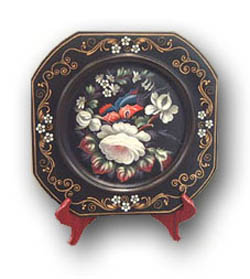
Traditional
white Zhostovo rose painted in the traditional way using acrylics
on a bisque plate based on a Slava Letkov design. Slava is one
of the seven master zhostovo artists in the world today.
Features of Zhostovo Landscapes and still life were the most
popular subjects of Zhostovo painting and fairy-tale characters
and Russian troika depictions were also often represented. But
the main motive of the art of Zhostovo has always been a
bunch of flowers in the centre of the tray. These realistic and
elegant
flowers are united into bouquets, wreaths or garlands, and
traditionally painted on a black or other dark coloured background.
Sometimes
the backgrounds are faux finished to imitate leather or mother
of pearl. Light backgrounds reminiscent of Chippendale trays
- definitely of French influence - are also sometimes used.
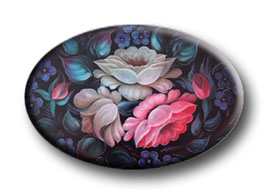
A
brilliant zhostovo bouquet with a very obvious central
light source which was designed and painted freehand
in acrylics for
my friend Di Singleton's book, Decorative
Painting Techniques
The unifying highlight strokes of Zhostovo
and the "wild grass" that
fill the trays tie the design together and emphasise
the unique and characteristic central light source of this
folk art.
Zhostovo
trays are also always accompanied by fine linework in
an ornate gold border.
A History of Zhostovo The art of Zhostovo began in the early 19th
century, when craftsmen began making various items of lacquered
papier mache. They opened their first workshop in 1825, producing
boxes, cases, snuff boxes and other articles. Trade in the trays
took place throughout the 19th century until a slump in the early
1900's but was revived 25 years later with the birth of the Zhostovo
tray-painting factory. The factory employed a workforce and Zhostovo
trays were painted like an assembly line - with a difference -
no two trays were the same. Each was a unique and brilliant work
of art. Zhostovo was painted entirely in oils and despite advancements
in materials available by the 20th century, the Zhostovo technique
remain preserved. Zhostovo painting is always traditionally
created as a brilliant masterpiece, and as such, repetition and
standardization are out of the question. The zhostovo artists painted
their design freehand, turning the trays often to pull all the
strokes towards them. A master painter paints the design. After
under-painting and initial shadows, the trays are baked in a special
oven and left overnight. The next day the shadows are intensified
and highlights added. Details like fine lines to emphasise highlights
and wild grass to provide life and movement to the design are added.
The trays then go to an apprentice who effortlessly paints the
ornate borders. The tray is finished with highly-glazed lacquer.
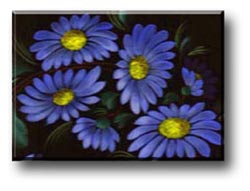
Master painters of the past have been relied
upon to pass on their knowledge. Today's Zhostovo masters, of whom
there are only seven in the entire world, are artists from a generation
of family dynasties. On the 6th of November 1993, the Zhostovo
Folk Craft was included into the State index of the most valuable
objects of culture of The Russian Federation by Presidential Decree.
The work of master Zhostovo artists is on display at various exhibitions
and museums not only in Russia, but also in many other countries
of the world.
Zhostovo today Zhostovo traditions have been kept alive by
modern day decorative artists who study the traditional methods
and investigate new materials and mediums available. Through improvisation
and individual talent, they have been able to produce their own
brilliant pieces of zhostovo and pass on the knowledge to others.
Zhostovo is commonly painted today using
the filbert brush. Mediums such as blending gel, clear glaze and
retarder are used
to allow acrylic paints to emulate the properties of oil paints
originally used to paint zhostovo. 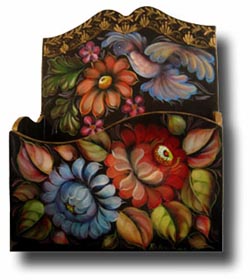
An example of Zhostovo painted in the contemporary
technique developed by Heather Redick , CDA. Blending gel is employed
to imitate the properties of oil paint and the filbert brush replaces
the traditional round sable.
There are many other ways of painting Zhostovo - this
advanced class project below is an example of one. Clear glaze medium and acrylic
paints were used to paint this vibrant zhostovo table. The
reds
and crimsons of the folk-style roses painted here were
layered using clear glaze medium to achieve an
almost luminous "light-from-within" look. A similar effect was achieved with the grapes.
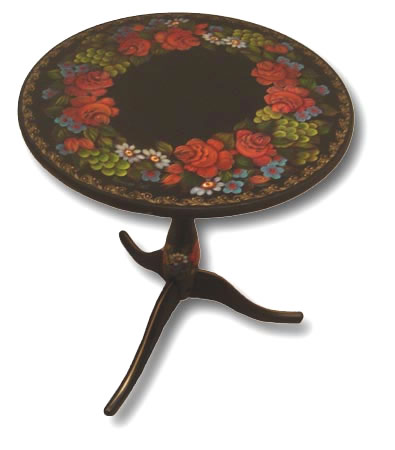
From a design point of view, this zhostovo project also represents a departure from the traditional central bouquet. Nonetheless it remains brilliant, colourful and rich on a traditional black background.
|